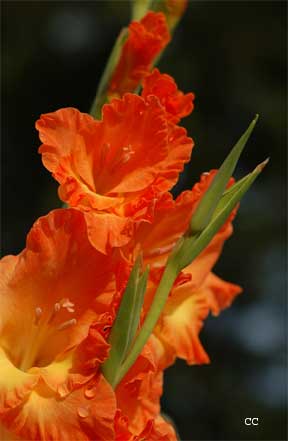In this age of striving for more size in everything from planes to posies, an ordinary landscape gardener is often quite overwhelmed. Take glads, for instance. In the shows the stalks get taller and the florets larger by the year. The trend is quite fine for shows but not exactly suited to my modest garden.
Recently I have been searching for “small-flowered glads”, and what treasures I have found! Their diminutive form increases their charm. The slender stems seldom need staking. Too, they require little space in flower gardens; so they should be welcomed by home owners with small yards.
Culture is like that for other glads. They require a fertile soil, plenty of sunshine and adequate moisture. Plant them four or five inches deep and about six inches apart, in rows or in clumps of half a dozen.

Frequent cultivation is important. Of course, if thrips move in, they must dealt with.
The fall digging is followed by storing in a cool, well ventilated place. Many basements are too warm. Our old-fashioned cave is just right.
Study Glad Catalogs
There is one guide in purchasing baby glads – the careful study of catalogs issued by specialists. It was interesting to read in one a few years ago: “We never cared enough for small glads to list very many of them … but with the increased demand for the small glads, hybridizers have bred more beauty and greater vigor into them.”
Any arranger can see the possibilities in the graceful slender stems bearing sweet blossoms which may look like an orchid, or face up at you, or resemble a star. Others are ruffled and some are laciniated, a term glad breeders use to denote a fringed edge on the petals.
Though they do not take the purple ribbons at the glad shows, the neat small blossoms can be arranged in an artistic design that will stop the most critical judge. It is in the garden and the home, though, that small glads are at their best.
A clump will come into bloom and add distinction and charm to a flower border, and they can be made into a pretty bouquet in the shortest time of any flower that may be brought in from the garden.
For personal wear in corsages, they are ideal and easy to work with. A wrist corsage made from a single blossom and a bud or two will make a little girl’s heart sing at a party or recital.
With breeders working avidly to produce a green flower, it is only natural that baby glad hybridizers would be in the game. The experts will welcome this exotic miniature to use in artistic designs. It seems that the field of miniature glads covers all possible glad colors, and many forms and styles. All this, plus a wide adaptability to the average garden.
Contributed by BG Brickell
